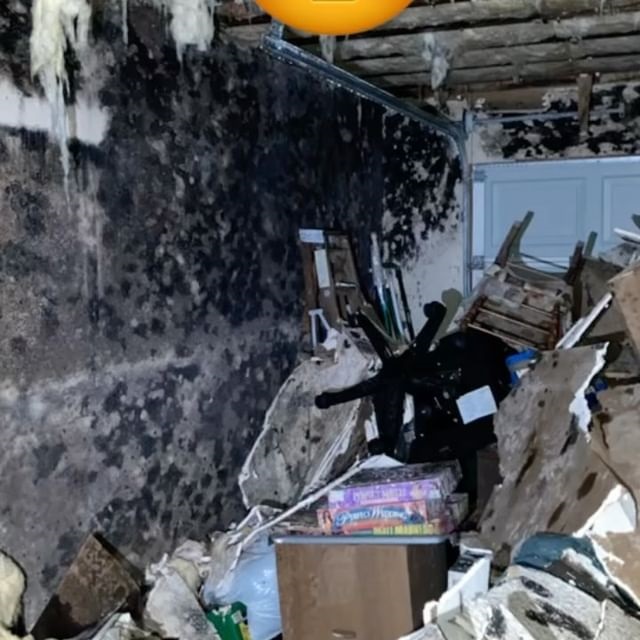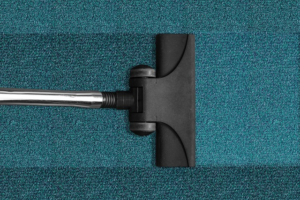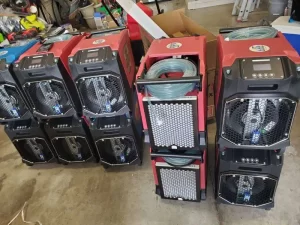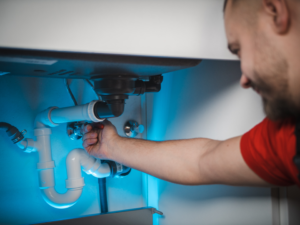Dealing with the aftermath of home floods can be stressful enough on its own. But what should homeowners do if they notice mold growth during cleaning? A few mold spores can quickly become a huge mold problem, creating a toxic living environment for you and your family.
We’ve seen it all at TN Flood Kings – floods, fires, mold, and sewage. Our IIRC-certified technicians are specially trained to help our Nashville and Mid-Tennessee neighbors deal with these difficult times as safely and efficiently as possible.
Let’s look at how to clean up mold after flooding and when to call in a professional mold remediation service.
How Quickly Does Mold Grow?
Did you know that the air around you is constantly filled with mold spores? These microorganisms migrate anywhere with a high moisture level, take root, and colonize. Mold colonies can sprout within 24 to 48 hours of exposure to excess moisture.
Normally, your HVAC helps reduce the potential for mold spores to colonize inside your home because it regulates moisture. However, you must turn that off for flooding and inspect your ducts before you resume use.
Act Fast: How To Prevent Mold After A Flood
Eliminating moisture sources, setting things out to dry quickly, and cleaning and sanitizing is the best way to prevent mold growth after exposure to flood water.
- Gear up. Wear rubber gloves, an n95 mask, and protective clothing to avoid health risks.
- Open your doors and windows if it isn’t too humid
- Remove standing water
- Clean up any debris and remove wet items
- Clean surfaces with a disinfectant. Scrub all surfaces, rinse with fresh water, and dry them quickly.
- If you can’t pull out saturated carpets, use a wet vacuum to remove excess water.
- Use fans to circulate air and dehumidifiers to remove moisture from it.
The above steps will help you dry your home as quickly as possible. Unfortunately, it may not be enough; drying out your home can take days, even weeks, and you have 24 to 48 hours to get ahead. So let’s review some of the best ways to deal with mold growing in your home.
How to Start Cleaning Mold Growth

Killing Growth with a Biocide
Biocide refers to chemical disinfectants like bleach that kill microorganisms like harmful bacteria, viruses, and fungi. These solutions kill live spores for an easy and effective way to treat mold in unfinished areas and concrete.
The bleach will kill living spores; however, dead spores still pose a risk. Continue to use safety gear until your mold problem is fully dealt with.
How To Safely Use Bleach
Bleach is very effective at killing mold spores, but it can also harm humans. Many of the precautions you take for cleanup can help, such as gloves and goggles, but there are a few extra tips you should follow.
- Do not mix bleach with ammonia
- Keep windows and doors open for ventilation
- Never use straight bleach; dilate one cup in one gallon of water
- Always protect your eyes, mouth, nose, and skin
Treating Mold Spores in Finished Rooms
Bleach and other biocides can permanently discolor fabric and furniture.
Additionally, it doesn’t penetrate drywall very well. Mold spores have a nasty habit of diving deep under carpets and behind walls, so treating a finished area in your home is more complex.
Wood furniture is not necessarily a loss. Many kinds of wood are sealed against moisture and mold spores. There are also fairly easy steps to repair wood furniture if it hasn’t given in to rot.
If you aren’t comfortable sanding, applying wood glue, replacing joints, or staining and sealing, wood restoration is best left to a professional.
Floors and Drywall
After flooding, it’s best to assume you must replace your flooring. Even if you can salvage the carpet, the pad beneath needs to be replaced. Water damage is tough on floors; silt, mud, and dirt can easily slip beneath tiles or laminate.
If you decide to try and save your floors, your best bet is to let a professional address the water damage, carpet removal, and cleaning process.
Drywall is easier if the mold problem hasn’t gotten too deep. Find the water line along the walls and measure 24 inches higher. Score a straight line with a utility knife, and then punch out the wall with a hammer. Remove wet insulation.
If you punch out your walls and discover even more mold, stop. This is a dangerous level of mold growth and should be left to the experts.
Don’t replace anything until your home is completely dried, cleaned, and sanitized. Otherwise, you risk contaminating the new materials and giving mold a way to sneak back into your home.
Signs You Need Professional Help with Mold Removal & Cleanup
Mold growth is often easy to spot, but sometimes the problem is deeper than it appears. Signs that your mold issue needs expert help include:
- The room smells musty
- The moldy surfaces are warped, cracked, or peeling
- A drop of bleach affects color within 2 minutes
- You can’t get the area dry
- More than 10 square feet of area is covered with mold
- You notice an increase in coughing, sore throats, sneezing, and runny noses
The CDC insists that you should not tackle mold cleanup alone if you have more than ten sq. ft. of mold coverage.
Instead, let our team lend a hand. We have specialized filters to help keep your air clean from mold spores and all the tools needed for more extensive mold extractions.
Protect Yourself and Your Family By Hiring a Professional Mold Remediation Service
Water damage restoration companies like the crew here at Flood Kings have years of experience dealing with water damage and mold cleanup within all types of homes. We have all the right tools to dry your house quickly and restore anything that can be salvaged.
Mold remediation can be dangerous for homeowners; let the experts come in and make the process as hassle-free as possible. You’ll also save money by avoiding having to rent equipment like sump pumps and carpet cleaners.
As an added bonus? We help our customers document damage for their insurance claims. Our expert crews know what insurance companies are looking for and can help you get maximum benefits from your claim.
Don’t tackle this dangerous mold project alone— call Flood Kings on our 24/7 emergency line.








